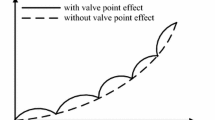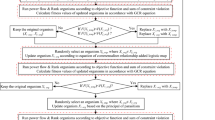Abstract
In this current research initiative, symbiotic organism search (mostly known as SOS) evolutionary computational methodology is used to find out solution for reactive power dispatch (ORPD) issues in power system. SOS algorithm is influenced by interaction among organisms of the ecosystem and independent from algorithm specific control parameters. In ORPD problem, multiple optimization objectives such as transmission line’s real power loss reduction, voltage stability-index improvement and reduction of total voltage deviation are undertaken. The control variables, e.g., generator and slack bus voltages, transformer tap setting and shunt capacitance are set to its optimal values in order to find the best possible solution of undertaken objective functions. A trial of adopted SOS methodology is performed on “IEEE-30 bus, -57 bus and -118 bus standard test cases” in power systems. Acquired sophisticated findings help to infer that the recommended SOS method is competent enough in comparison with other cited methods in the progressive literatures.










Similar content being viewed by others
Abbreviations
- \({\text{BF}}_{(1)}\),\({\text{BF}}_{(2)}\) :
-
Benefit factors
- \(B_{(ij)}\),\(G_{(ij)}\) :
-
Transfer susceptance and conductance, respectively
- \(F_{(ji)}\) :
-
\(\left( {i,j} \right){\text{th}}\) Components of bus admittance matrix (\(Y_{{({\text{Bus}})}}\))
- \(L_{(k)}\) :
-
Voltage stability index of the \(k{\text{th}}\) node
- \(M\_V\) :
-
Relationship between vectors \(X_{(i)}\) and \(X_{(j)}\)
- \(N_{{({\text{B}})}}\),\(N_{{({\text{C}})}}\),\(N_{{({\text{G}})}}\),\(N_{{({\text{l}})}}\),\(N_{{({\text{L}})}}\),\(N_{{({\text{T}})}}\) :
-
Number of buses, shunt capacitors, generator buses, transmission lines, load buses and transformer branches, respectively
- \(P_{{({\text{D}})}}\),\(P_{{({\text{G}})}}\),\({\kern 1pt} P_{{({\text{Loss}})}}\) :
-
Active power demand, generation and transmission line losses, respectively
- \(P\_V\) :
-
Relationship between parasite vectors
- \(Q_{{({\text{C}})}}\),\(Q_{{({\text{D}})}}\),\(Q_{{({\text{G}})}}\) :
-
Reactive power compensation, demand and generation, respectively
- \(r_{(m)}\) :
-
Random number specified within [0, 1]
- \(S_{(l)}\) :
-
Complex power of branch l
- \(T_{(i)}\) :
-
Transformer tap (integer) installed in the ith line
- \(V_{{({\text{G}})}}\) :
-
Generator voltage (continuous)
- \(V_{(i)}\), \(V_{(j)}\), \(V_{(i)}^{{{\text{ref}}}}\),\(V_{{({\text{L}})}}\) :
-
Voltages at the i and j buses, referred (i.e., 1.0 pu) and load voltages, respectively
- \(X_{(i)}\), \(X_{(j)}\),\(X_{{({\text{best}})}}\) :
-
iTh and jth organism in the ecosystem and highest degree of adaptation, respectively
- \(\left( {X_{{{\text{best}}}} - X_{j} } \right)\) :
-
Benefit of \(X_{(j)}\)
- \(X_{{(i\,{\text{new}})}}\), \(X_{{(j\,{\text{new}})}}\) :
-
Mutuality effort given by the organisms to enhanced adaptability at the buses i and j, respectively
- \(Y_{(jj)}\), \(Y_{(ji)}\) :
-
Self and mutual admittances, respectively
- \(\delta_{(i)}\), \(\delta_{(j)}\) :
-
Phase angle at i and j buses, respectively
- \(\alpha_{(ij)}\) :
-
Phase angle of the term \(F_{(ij)}\)
References
M. A. Abido, Multi objective optimal VAR dispatch using strength pareto evolutionary algorithm, in IEEE Congress on Evolution Computing Vancouver, BC, Canada (2006), pp. 730–36
C. Dai, W. Chen, Y. Zhu, X. Zhang, Seeker optimization algorithm for optimal reactive power dispatch. IEEE Trans. Power. Syst. 24(3), 1218–1231 (2009)
A.A. Abou El Ela, M.A. Abido, S.R. Spea, Differential evolution algorithm for optimal reactive power dispatch. Electr. Power Syst. Res. 81(2), 458–464 (2011)
U.H.H. Tehzeeb, R. Zafar, S.A. Mohsin, O. Latee, Reduction in power transmission loss using fully informed particle swarm optimization. Electr. Power Energy Syst. 43, 364–368 (2012)
S. Duman, Y. Sönmez, U. Güvenç, Y. Yörükeren, Optimal reactive power dispatch using a gravitational search algorithm. IET Gener. Transm. Distrib. 6(6), 563–576 (2012)
B. Mandal, P.K. Roy, Optimal reactive power dispatch using quasi-oppositional teaching learning based optimization. Electr. Power Energy Syst. 53, 123–134 (2013)
B. Shaw, V. Mukherjee, S.P. Ghoshal, Solution of reactive power dispatch of power systems by an opposition-based gravitational search algorithm. Electr. Power Energy Syst. 55, 29–40 (2014)
A. Ghasemi, K. Valipour, A. Tohidi, Multi objective optimal reactive power dispatch using a new multi objective strategy. Electr. Power Energy Syst. 57, 318–334 (2014)
M. Ghasemia, S. Ghavidela, M.M. Ghanbarianb, A. Habibi, A new hybrid algorithm for optimal reactive power dispatch problem with discrete and continuous control variables. Appl. Soft Comput. 22, 126–140 (2014)
M. Ghasemi, S. Ghavidel, M.M. Ghanbarian, M. Gitizadeh, Multi-objective optimal electric power planning in the power system using Gaussian bare-bones imperialist competitive algorithm. Inf. Sci. 294, 286–304 (2015)
A. Rajan, T. Malakar, Optimal reactive power dispatch using hybrid Nelder–Mead simplex based firefly algorithm. Electr. Power Energy Syst. 66, 9–24 (2015)
M.H. Qais, H.M. Hasanien, S. Alghuwainem, Parameters extraction of three-diode photovoltaic model using computation and Harris Hawks optimization. Energy 195, 117040 (2020)
M.A. Shaheen, H.M. Hasanien, S.F. Mekhamer, H.E. Talaat, Optimal power flow of power systems including distributed generation units using sunflower optimization algorithm. IEEE Access 7, 109289–109300 (2019)
M.A. Shaheen, H.M. Hasanien, A. Alkuhayli, A novel hybrid GWO-PSO optimization technique for optimal reactive power dispatch problem solution. Ain Shams Eng. J. 12, 621–630 (2020)
L.S. Titare, P. Singh, L.D. Arya, S.C. Choube, Optimal reactive power rescheduling based on EPSDE algorithm to enhance static voltage stability. Int. J. Electr. Power Energy Syst. 63, 588–599 (2014)
L.D. Arya, P. Singh, L.S. Titare, Anticipatory reactive power reserve maximization using differential evolution. Int. J. Electr. Power Energy Syst. 35(1), 66–73 (2012)
M.Y. Cheng, D. Prayogo, Symbiotic organisms search: a new metaheuristic optimization algorithm. Comput. Strut. 139, 98–112 (2014)
R.P. Singh, V. Mukherjee, S.P. Ghoshal, Optimal reactive power dispatch by particle swarm optimization with an aging leader and challengers. Appl. Soft Comput. 29, 298–309 (2015)
E. Mezura-Montesa, C.C.A. Coello, Constraint-handling in nature-inspired numerical optimization: past, present and future. Swarm Evol. Comput. 1(4), 173–194 (2011)
R. Mallipeddi, S. Jeyadevi, P.N. Suganthan, S. Baskar, Efficient constraint handling for optimal reactive power dispatch problems. Swarm Evol. Comput. 5, 28–36 (2012)
S. Verma, S. Saha, V.A. Mukherjee, novel symbiotic organisms search algorithm for congestion management in deregulated environment. Exp. Theor. Artif. Intell. 29, 1–21 (2015)
Funding
No fund has been accepted from any funding agency for this paper.
Author information
Authors and Affiliations
Corresponding author
Ethics declarations
Conflict of interest
The authors declare no conflict of interest with any other individual or organization.
Additional information
Publisher's Note
Springer Nature remains neutral with regard to jurisdictional claims in published maps and institutional affiliations.
Rights and permissions
About this article
Cite this article
Prasad, D., Mukherjee, V. & Singh, R.P. Application of SOS Algorithm for Solution of ORPD Problem. J. Inst. Eng. India Ser. B 103, 747–766 (2022). https://doi.org/10.1007/s40031-021-00700-8
Received:
Accepted:
Published:
Issue Date:
DOI: https://doi.org/10.1007/s40031-021-00700-8




